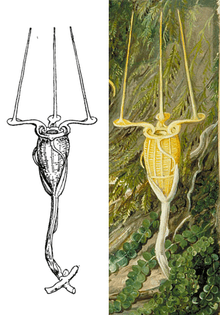Thismia neptunis
Thismia neptunis is a species of Thismia endemic to Malaysia. It was discovered by Italian botanist Odoardo Beccari in 1866, and described in 1878. It was not observed again until 2017, when it was first photographed by a team of biologists from the Czech Republic.[1][2]
| Thismia neptunis | |
|---|---|
 | |
| Left: Beccari's original illustration. Right: North's painting based on the original illustration. | |
| Scientific classification | |
| Kingdom: | Plantae |
| Clade: | Tracheophytes |
| Clade: | Angiosperms |
| Clade: | Monocots |
| Order: | Dioscoreales |
| Family: | Burmanniaceae |
| Genus: | Thismia |
| Species: | T. neptunis |
| Binomial name | |
| Thismia neptunis Becc. 1878 | |
T. neptunis lives underground, and is a myco-heterotroph, a plant which obtains nutrients through a parasitic relationship with fungi. It doesn't bloom every year, and when it does, its flower appears above the soil for only a few weeks.[3]
References
- Sochor, Michal; Egertová, Zuzana; Hroneš, Michal; Dančák, Martin (2018). "Rediscovery of Thismia neptunis (Thismiaceae) after 151 years". Phytotaxa. 340: 71–78. doi:10.11646/phytotaxa.340.1.5.
- Nelson, Bryan (March 4, 2018). "Weird subterranean plant not seen in 150 years re-emerges from the underworld". Mother Nature Network.
- Daley, Jason. "After 150 Years, This Bizarre Plant Was Rediscovered in Malaysia". Smithsonian.com. Retrieved 9 March 2018.
| Wikimedia Commons has media related to Thismia neptunis. |
This article is issued from Wikipedia. The text is licensed under Creative Commons - Attribution - Sharealike. Additional terms may apply for the media files.